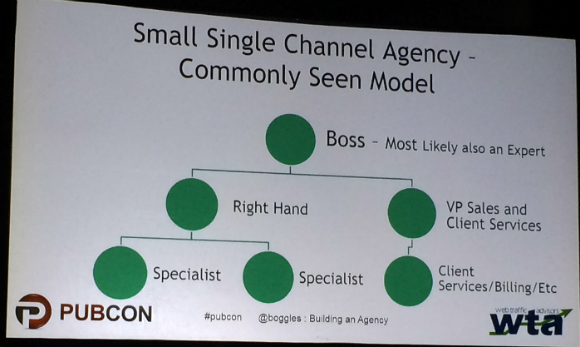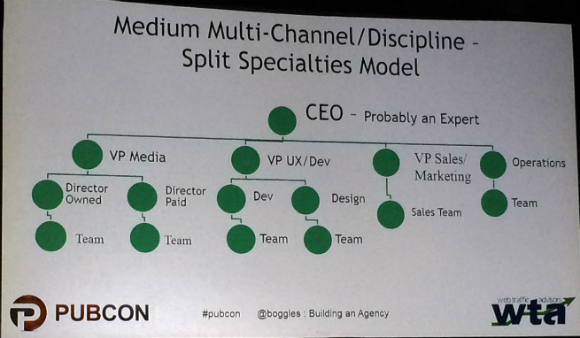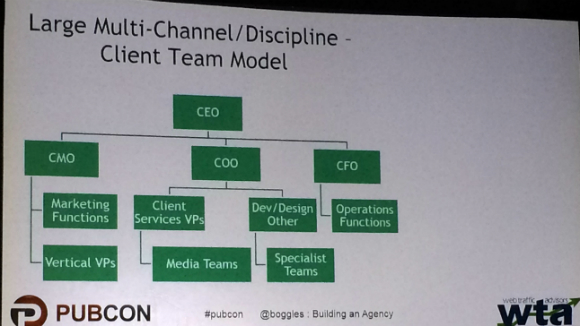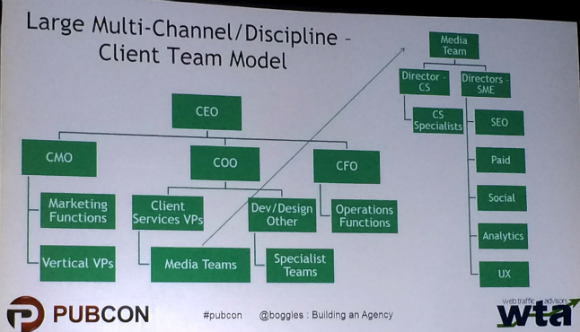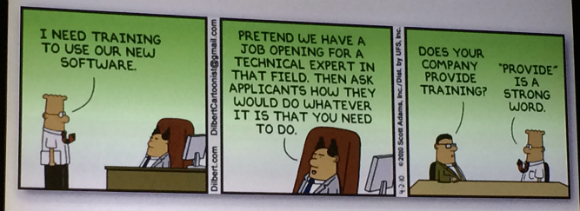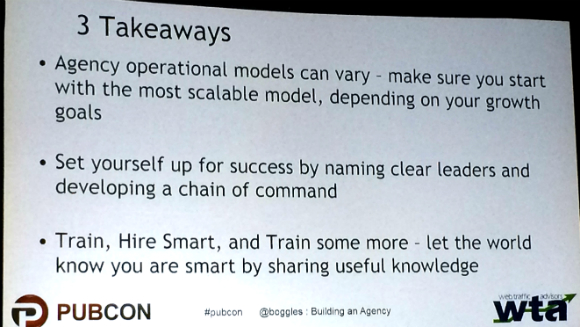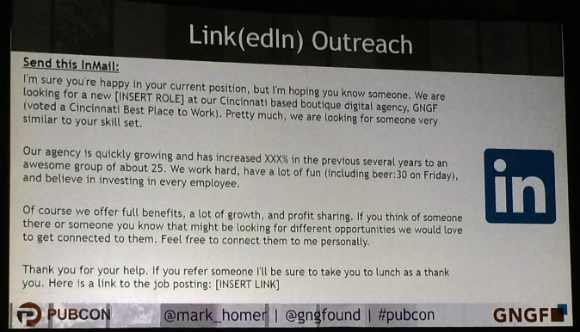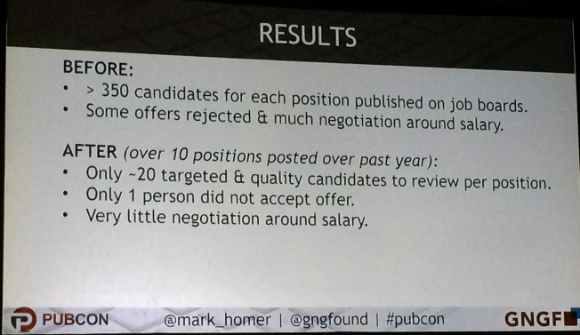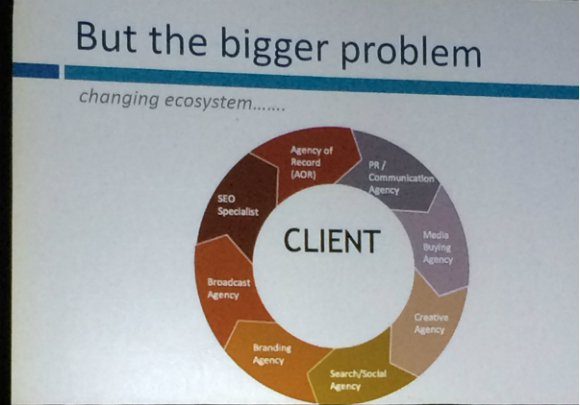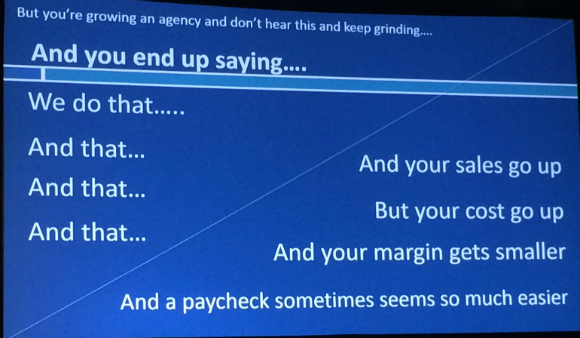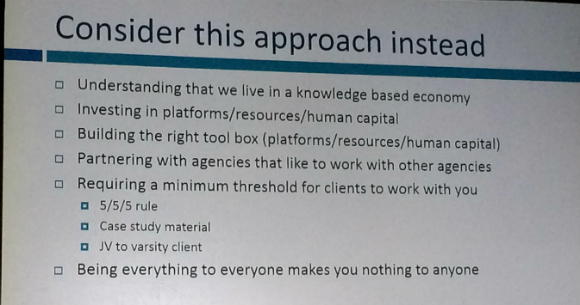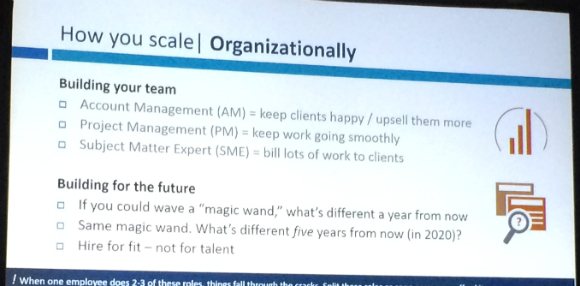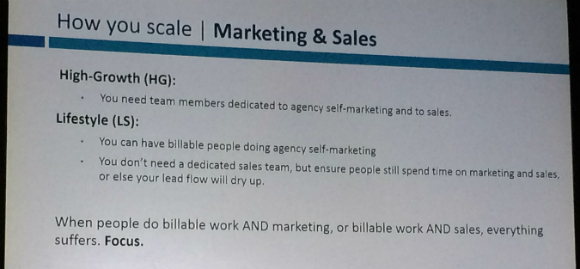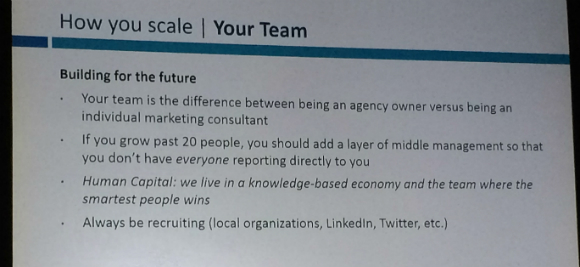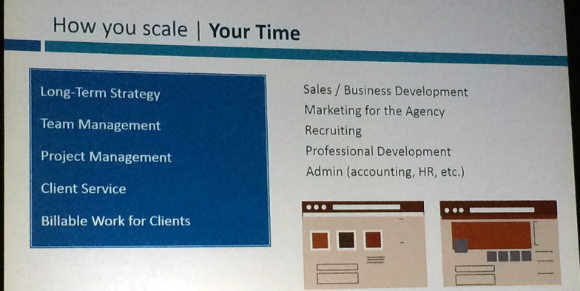Building an SEO/SEM Agency – #Pubcon Liveblog
What makes a great SEO or SEM agency? This question applies to companies looking to hire an agency, since they need to make sure they’re working with an agency team that can not only write a good RFP but also drive their KPIs. However, in this Pubcon Las Vegas session the speakers come at it from the agency’s point of view: How can you plan, start, hire, train and grow a successful agency team that can produce as well as sell?
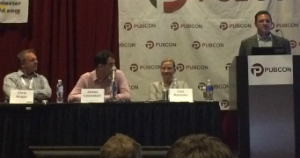
Speakers:
Chris Boggs, Founder and CEO, Web Traffic Advisors
Mark Homer, CEO, Get Noticed Get Found, Inc.
James Loomstein, Founder and CEO, Digital Space Consulting
Moderator: Lisa Raehsler, Founder and SEM Strategist, Big Click Co.
Chris Boggs: So You Want To Build an Agency
Chris Boggs (@boggles) starts by laying out his agenda, as follows:
- Agency Models: Small to Large
- Subject Matter Expert + Client Services Expert
- Training and Thought Leadership
- A Couple Quick Hiring Ideas
Agency Models
What type of agency?
- SEO
- Paid media
- Social media
- Analytics/conversion
- All of the above – full service integrated
As long as you can deliver consistently on any of these channels, you can succeed as an agency. However, the one-channel agency is more of a dying breed, and integrated agencies are more along the lines of what’s coming out. You need some chops across the board to pull that off.
If you’re building an agency and just going to do one channel, know who will you go to for supplementary services such as web/app development, design/CMS, persona/segmentation, testing lab, industry/vertical focus, public relations. Consider how you will deliver on these if clients ask for them.
There are three types of agency models: small, medium and large.
1. Small Single-Channel Agency
This is a commonly seen model:
Sales in a small single-channel agency can be integrated very easily. There’s great continuity between sales and service because they may be the same person in a small model.
Often growth occurs at the bottom quickly without keeping the right ratio of experience. This can win or fail.
2. Medium Multi-Channel/Discipline
This is a split-specialties model:
Clients may have an unreasonable expectation sometimes that the CEO is available to help them. There’s a split between media (specialties), UX/dev, sales and marketing, and operations. This is one of the easiest ways to start to scale at a mid-sized level. Client services live under each of the segments. The difficulty with this model is scaling while maintaining margin. To best support your margin efforts, have in place the nice structure so you can deliver more hours on a lower-rate employee.
3. Large Multi-Channel/Discipline
This is a client team model:
You end up having hubs of teams across your agency that can deliver for the client. The goal is to upsell a client across all your horizontals. This model provides a useful way to show you have expertise across all these industries.
Scaling this model:
Operational efficiency is the key to this model.
Subject Matter Expert + Client Services Expert
The SME (subject matter expert) and AD (account director) are different but serve the same clients. His biggest tip from his experience: You have to name one as senior to the other. If you have one leader, then the buck stops somewhere.
Thoughts on Thought Leadership
Many larger agencies have moved away from having writing- and speaking-focused gurus, yet the concept of developing thought leadership is gaining importance across industries. It serves two purposes:
- Establishing credibility within industry and outside
- Ongoing continuing education is required for true thought leader
Training is essential for building and growing an agency.
Ongoing formal training is paramount to success in growing employees. Too many agencies just say, “Sink or swim.” Important to train on execution plus reporting and customer service, too. He suggests using multiple variants of reporting templates and other items that are consistent.
Partners should provide training (e.g., BrightEdge).
Training allows leaders to gain respect and credibility (ties into broader thought leadership). Trainers should always learn something from interacting with their trainees, otherwise you aren’t doing it right!
Takeaways:
Mark Homer: Building a Team
Mark Homer (@mark_homer) says to use the lessons from influence, conversion optimization and psychographics to build your rock star agency team. He’s started three startups. He’ll focus on the topic of hiring since that’s what he’s been doing a lot of recently.
Who has time for hiring when you’re managing people, managing clients and managing profit and loss (finances)? Today, agencies can get 300 applicants for a single job posting because of automated bots firing people’s resumes at them based on preset criteria.
How can we solve this challenge:
- Reduce time of recruiting
- Find more quality candidates
- Filter out bad candidates
- Increase chance of candidate saying yes
The answer is to practice what we preach! Use psychographics, psychology of influence and conversion optimization!
Psychographics: Facebook
To reach better candidates, fill potential candidates’ streams with your job ads (sponsored posts). Filter by:
- Geography (within x miles of our office)
- Degree
- Current occupation
LinkedIn Outreach
Manually search and filter for schools, past companies, location. Then send InMail. He says this letter is gold:
He gets emails back with three potential responses:
- Thanks but I’m not looking.
- Oh, my friend is looking!
- Funny enough, I’m looking!
Influence: Increase YES Post-Offer
Apply the principles of Influence (from the book by Robert Cialdini) to your agency’s hiring practices. Here’s what Homer came up with.
Scarcity: Make candidates jump through hoops a little more. For example, ask every candidate to record a video to apply. He suggests saying, “Create a YouTube video entitled ‘GNGF Awesome and Fun Interview Video – [Your Name]’ that tells us creatively 1) Why you are awesome and fun, 2) Why you want this opportunity, and 3) Why you want to work at GNGF.”
Note: Ask them to provide five references and only call the last two.
Social proof: Your applicants’ videos are now creating social proof. Look at how many videos are being submitted and viewed and making your company look cool and in demand.
Liking: They created a compilation video of clips from all the videos people submitted. This shows potential applicants that other people similar to them are applying.
Commitment and consistency: If people commit, orally or in writing, to an idea or goal, they are more likely to honor that commitment.
The results of using these new application requirements:
James Loomstein: Growing Our Agencies
James Loomstein (@jloomstein) begins with sports analogies. Chris Paul is a pointguard who plays for the LA Clippers. His job is not about moving the ball up the floor. His job is to make sure everyone is doing their part. When running an agency, you have to make sure everyone is doing their part. Your agency is like a NASCAR pit crew. There’s a team and each person has a specific role. They work together to make the car go around the track as fast as possible. All the cars on the track are using the same tools and going around the same track and playing by the same rules. What makes one team better than every other team? The people.
Everything builds on the previous thing. Everyone knows where everyone’s going. Everyone knows their role to play on the team. Everyone knows what to do next. It’s not directionless.
The advertising model is changing. The problem that we have to solve is tying actions and activities to results and ROI. It’s impossible for anyone or agency to be a master of everything. The one-stop digital shop is a dying breed. The overhyped 500+ employee agency is falling apart. Microspecialists are the agencies that are winning. Be specialized in something, like the NASCAR pit crew.
The bigger problem is the changing ecosystem around the client:
The client is looking for all their agencies to play in the same playground together. You don’t have to be everything to everyone. Be hyperfocused on something and grow, scale and get known for “the thing.”
What’s happening?
- Agencies are doing everything and nothing is happening.
- Your agency needs to understand your core offering and find your superpower (everyone has a superpower).
How you grow is:
- Understand the story you tell, and tell a story people want to hear.
- Learn what to say to prospects when you’re not for them.
- Remember that if you’re everything to everyone, then you’re nothing to anyone.
The problems you face with your agency are scalability and repeatability. The ability to say “we’re not for you” is a big shift and a big way to grow. It’s hard to do!
Does this sound like you?
- Increased sales
- Lower % growth revenue
- Higher overhead costs
- Decreased specialization
- Smaller YOY incremental growth
There has to be a better way. Decide on the type of agency you want to be and what services to offer:
- Growth
- Lifestyle
- Sector
- Specific industry
- Strategic solution (app development)
Decide your long-term goals for building an SEM agency. Which matters more to you?
- High Growth: Focused on growing fast to maximize valuation so you can sell the agency.
- Lifestyle: Focused on quality of life, building a well-paying job that supports your lifestyle outside work.
How You Scale Your Growing Agency
26,000+ professionals, marketers and SEOs read the Bruce Clay Blog
Subscribe now for free to get:
- Expert SEO insights from the "Father of SEO."
- Proven SEO strategies to optimize website performance.
- SEO advice to earn more website traffic, higher search ranking and increased revenue.

4 Replies to “Building an SEO/SEM Agency – #Pubcon Liveblog”
This knowledge is simply priceless. Thank you. I run a small SEO agency, but I have a lot of new ideas now.
Thank you for the thorough coverage Virginia – well written and so accurate! As usual the BC team had a great presence and it was fun seeing many of you.
Thanks for the feedback, Chris. I always shoot to do sessions justice for readers. I felt your session was an interesting reference point in the mix, as most sessions focus on production and this was unique in helping on the operational side. It was good to see you around. Thanks for the awesome content! :)
LEAVE A REPLY





